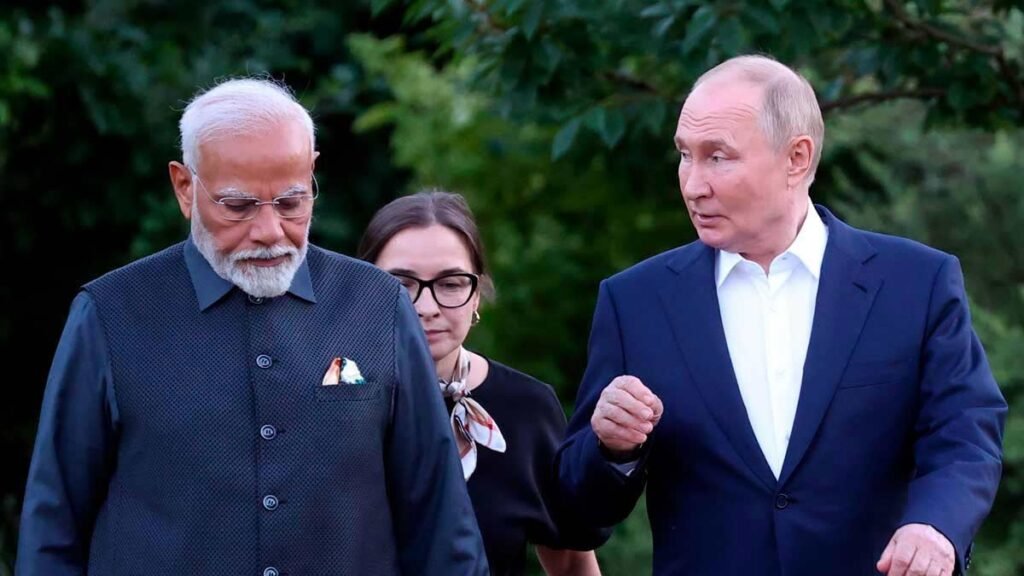Following his visit to Ukraine and a significant call from U.S. President Joe Biden, Indian Prime Minister Narendra Modi has engaged in discussions with Russian President Vladimir Putin. The conversation is part of a broader diplomatic effort amid the ongoing conflict in Ukraine. Modi’s outreach to Putin underscores India’s delicate balancing act, maintaining strategic ties with both the U.S. and Russia. The dialogue between the leaders focused on enhancing bilateral cooperation, addressing global security concerns, and exploring avenues for peaceful resolution in the region.

Intense Diplomatic Activity Sparks Speculation, but New Delhi’s Role in Russia-Ukraine Conflict Remains Unclear
A surge in diplomatic efforts has fueled speculation about New Delhi’s involvement in the Russia-Ukraine conflict. However, despite the flurry of high-level meetings and discussions, there is still no clear indication of whether India is positioning itself as a peacemaker in the ongoing crisis. The uncertainty surrounding New Delhi’s role has left observers questioning the nation’s strategic intentions in the complex geopolitical landscape.
Modi’s Diplomatic Maneuvering: Engaging Russia, Ukraine, and the United States
Three days after his return from Ukraine and following a key conversation with U.S. President Joseph Biden, Indian Prime Minister Narendra Modi reached out to Russian President Vladimir Putin. During the call, Modi shared insights from his recent visit to Kyiv, where he held discussions with Ukrainian President Volodymyr Zelenskyy. This series of high-profile diplomatic engagements, including Modi’s participation at the upcoming BRICS summit, has sparked speculation about India’s potential role in mediating the ongoing Russia-Ukraine conflict. However, the Indian government has yet to confirm any official peace initiative.
India’s Strategic Diplomacy: Engaging Both Sides
On Tuesday, the Indian Ministry of External Affairs released a statement regarding Modi’s conversation with Putin, emphasizing the importance of dialogue and diplomacy in resolving the Russia-Ukraine conflict. The statement also highlighted Modi’s commitment to sincere and practical engagement among all stakeholders to achieve a lasting and peaceful resolution. However, the readout notably did not address Russia’s large-scale missile and drone assault on Ukraine, which occurred just a day prior and drew strong condemnation from Washington.

Meanwhile, the Kremlin’s account of the call provided additional context. According to the Russian Ministry of Foreign Affairs, Modi informed Putin about his recent visit to Kyiv and reiterated India’s commitment to finding a political and diplomatic solution to the conflict. Putin, in turn, shared his perspective on the actions of the Ukrainian government and its Western allies, while also discussing the new economic agreements signed between India and Russia in July. Furthermore, the Kremlin confirmed Modi’s participation in the BRICS summit scheduled for October 22-24 in Kazan.
U.S. Response: Commending Modi’s Role
On the American side, the White House issued its own statement following Modi’s call with President Biden. The statement praised Modi for his historic visits to Poland and Ukraine—the first by an Indian Prime Minister in decades—and for his message of peace and humanitarian support, particularly in Ukraine’s energy sector. Although the White House readout did not explicitly mention an Indian-led peace proposal, it reaffirmed the commitment of both leaders to a peaceful resolution of the conflict based on international law and the UN Charter.
John Kirby, the U.S. National Security Communications Advisor, also weighed in on the conversation, indicating that the U.S. would welcome any nation’s efforts to facilitate peace talks. Kirby stressed the importance of aligning with President Zelenskyy’s just peace proposal and incorporating his perspectives into any discussion aimed at resolving the conflict.
India’s Ambiguous Role: Peacemaker or Strategic Partner?
Despite the diplomatic activity, Indian officials have remained tight-lipped about the country’s role in mediating between Russia and Ukraine. While countries like Turkey and Hungary have previously taken on similar roles, India’s approach appears to be more cautious. During his visit to Kyiv on August 23, External Affairs Minister S. Jaishankar deflected questions about a possible Indian peace initiative, stating only that any productive exercise would naturally require the involvement of the concerned party—in this case, Russia. Similarly, in Moscow on July 9, then Foreign Secretary Vinay Kwatra reiterated India’s readiness to contribute to peace and stability, but without committing to any specific actions.
Adding to the uncertainty, Ukrainian President Volodymyr Zelenskyy mentioned in an interview with Indian media that India was one of the Global South countries he had suggested as a potential venue for the second edition of the Burgenstock Peace Summit, scheduled for November. However, Zelenskyy also noted that it might be challenging for a country like India, which did not endorse the communique from the first peace summit, to host the next round of talks.

A Broader Context: India’s Geopolitical Calculus
India’s engagement with both Russia and Ukraine, as well as its strong ties with the United States, highlight its complex and strategic approach to international diplomacy. As a member of BRICS, India has historically maintained close relations with Russia, even as it has deepened its partnerships with Western nations. This delicate balancing act has allowed India to navigate the shifting geopolitical landscape while pursuing its own national interests.
In recent years, India’s foreign policy has increasingly focused on expanding its global influence, particularly in the context of the ongoing rivalry between the U.S. and China. By positioning itself as a potential mediator in the Russia-Ukraine conflict, India could further enhance its standing as a key player on the world stage. However, this role also carries significant risks, as it requires India to manage its relationships with both Moscow and Washington carefully.
The upcoming BRICS summit in Kazan will likely provide another platform for India to engage with Russia and other member states on key issues, including the conflict in Ukraine. At the same time, Modi’s conversations with Biden and Zelenskyy suggest that India is also keen to maintain strong ties with the West, particularly in areas such as economic cooperation, defense, and energy security.

Conclusion: A Delicate Balancing Act
As speculation continues about India’s role in the Russia-Ukraine conflict, the country’s leadership appears to be navigating a complex and evolving diplomatic landscape. Modi’s recent engagements with Putin, Biden, and Zelenskyy reflect India’s strategic approach to international relations, which seeks to balance its historical ties with Russia with its growing partnerships in the West. Whether India will emerge as a peacemaker in the conflict remains to be seen, but its active involvement in diplomatic discussions underscores its increasing influence on the global stage.
In the coming months, the world will be watching closely to see how India leverages its diplomatic relationships to contribute to peace and stability in the region. As the BRICS summit approaches and the conflict in Ukraine continues, New Delhi’s next steps will be critical in shaping the future of its foreign policy and its role in the international community.
Stay tuned to Club4Celebs for more updates.


